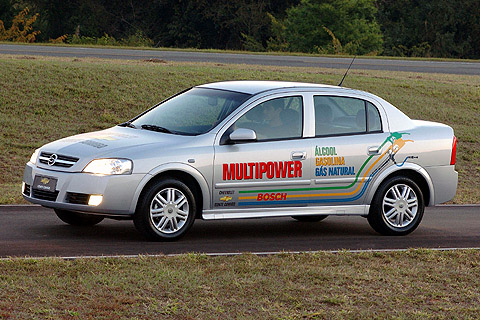In his 2006 State of the Union address, President Bush made a commitment "to replace more than 75 percent of our oil imports from the Middle East by 2025." He also said ethanol from not only corn, as now produced in the U.S., but also cellulosic ethanol from wood chips and stalks and switch grass would be key in achieving this goal. Brazil, which should be independent of imported oil this year, is showing it doesn’t require any advanced technology like fuel cells. Not only will Brazil be foreign oil-independent, its motorists will not be dependent on only one fuel.

When the first of the fuel crises hit, the Brazilian government reacted with Proalcool in 1975, 75-percent gasoline blended with 25-percent ethanol produced from sugar cane, a major Brazilian crop. It responded to the second crisis with vehicles running on pure alcohol. By the mid-1980s, over 90-percent of Brazilian cars and light trucks ran on alcohol that was substantially cheaper than gasoline and available everywhere in Brazil.
When oil prices dropped in the mid-1980s, coupled with the discovery of new offshore oil fields, gasoline became cheaper. This was further compounded by a drought and a poor sugar harvest disrupting the supply of alcohol. Then by 1989, sugar prices started to rise dramatically and producers exported sugar rather than turn it into fuel. By 1997, alcohol capable cars represented less than 1-percent of new vehicles sold in Brazil.
Brazil learned a lesson from these ups and downs. The result were flex-fuel vehicles (FFV) that could run on any fuel from pure gasoline to pure alcohol. All Brazilian gasoline is blended with at least 20- to 25-percent ethanol. Some 29,000 out of 31,000 fueling stations in Brazil also offer 100 percent ethanol for the older alcohol-only vehicles. Brazil currently has between 3-million and 4-million ethanol fueled vehicles. Interestingly, there are about 6 million flex-fuel vehicles in the U.S., but only 600 stations where they can refuel with E85.
In Brazil, ethanol costs, on average, about half of what gasoline does, plus motorists receive tax credits for its cleaner tailpipe emissions. The bottom line is that Brazil is now almost immune to the instabilities, and price flunctations in gasoline supplies. Brazilians can fill their tanks with any blend of gasoline or ethanol depending on which is cheaper or more convenient to obtain. Today, over 70-percent of the automobiles sold in Brazil -- that's over a million annually -- are flex fuel vehicles (that cost no more than one that is gasoline powered.)
Some Brazilian flex-fuel vehicles can also run on compressed natural gas (CNG,) alcohol, and gasoline. Most of these are aimed at taxi fleets with their own CNG facilities, though CNG is available at some public fueling stations.
As shown by Brazil, flex-fuel vehicles could be the answer to our fuel shortages and large spikes in prices. Rather than releasing petroleum from the national petroleum reserve, more ethanol could be produced, provided the production facilities were in place and feedstocks immediately available.
Gasoline producers would have serious competition, making prices much more stable, and gouging less likely to occur. Many people would probably be willing to pay more for a FFV as insurance, just in case gasoline or ethanol become unavailable or too expensive. Because modifications to run a vehicle on ethanol aren’t extensive -- the cost is only about a $100 more -- Brazilians have made it the norm.
Fermentation of Brazilian sugar cane produces much more ethanol as compared to corn. For each unit of energy expended to turn cane into ethanol, 8.3 times as much energy is created (1 to 8.3.) Compare that to corn which gets a maximum of 1.3 times the engery from a single unit (1 to 1.3.) Research is underway in Brazil to increase this to 1 to 10. Also, no fossil fuel is used in the process of converting sugar cane to ethanol. The residue from the stalks is used to generate the necessary electricity, and to fertilize the sugar cane fields.
Brazil has an ethanol surplus to export. But the U.S., and other countries, should be hesitant to trade foreign oil dependency, for foreign alcohol dependency. However, using and the Brazilian expertise would be a wise investment.
We could also look at fuel economy in fuel in a new way, that is 'miles-per-gallon of gasoline produced from fossil fuel' (MPGFF.) Thus, while vehicles running on E85 get less MPGs, they get significantly more MPGFFs. For example:
FUEL ECONOMY - Combined City/Highway Mileage
| Vehicle | MPG City | MPGFF (miles-per-gallon-of-fossil-fuel) |
| Chevrolet Tahoe Gasoline | 17 | |
| E85 | 13 | 88 |
| Chevrolet Impala gasoline | 24 | |
| E85 | 19 | 126 |
| Ford Crown Victoria gasoline | 21 | |
| E85 | 14 | 93 |
| Toyota Prius gasoline | 55 | |
| E85 | 35-45 | 233-300 |




